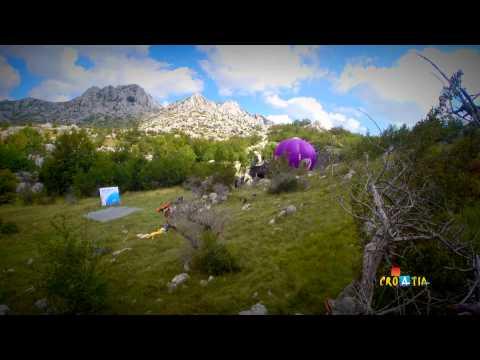Imagine waking in the middle of the night to an elephant ripping the roof from your house in search of food. This is a reality in some communities in Africa where, as wild spaces shrink, people and elephants are competing for space and resources like never before. In this engaging talk, zoologist Lucy King shares her solution to the rising conflict: fences made from beehives that keep elephants at bay while also helping farmers establish new livelihoods. The TED Talks channel features the best talks and performances from the TED Conference, where the world's leading thinkers and doers give the talk of their lives in 18 minutes (or less). Look for talks on Technology, Entertainment and Design -- plus science, business, global issues, the arts and more. You're welcome to link to or embed these videos, forward them to others and share these ideas with people you know.
Video Script::
Translator: Jiasi Hao Proofreader: Coco Shen Ever since I can remember, The African elephant has always been an awe-inspiring being. On this planet, they are the largest mammals on land. Can weigh up to 7 tons, Shoulder height is 3.5 meters. They can eat 400 kg of food a day, And in their 50-60 years of life, They spread very important plant seeds thousands of miles away. At the heart of the elephant's compassionate and complex society are its chiefs. These strong female leaders train young elephant cubs And guide elephant herds in the challenging African woods, Come look for food, water, and safety. Their society is so complicated, So that we have n’t fully understood How they communicate, how they express themselves in language, How their intonation works. And we have n’t really understood how they navigate themselves across the land, How they remember the safest place to cross the river. I ’m pretty sure everyone here Facing this most incredible animal Have similar positive reactions. Almost everyone has seen related documentaries, Understand their intelligence, Or you are lucky enough to take a wild adventure I can see them with my own eyes. But I think how many of you They have been really and completely scared. I am lucky to be in South Africa Bring up by two parents who are teachers. They have long holidays, but very limited budgets. So we often drive our old Ford cars, With my sister, we will stuff the trunk together, Bring a tent to different places in South Africa Wildlife sanctuary camping. For a young and budding zoologist, like me, this activity is like heaven. But I remember even though I was so young, I already feel like a tall electric fence that isolates the animal sanctuary More violating and splitting. Of course, the electric fence is to prevent elephants from entering the community, But they also isolate communities from the wild world. This is indeed a challenge for me, especially at that age. Until I moved to Kenya when I was 14, I was exposed to the vast open wild areas of East Africa. Now, it is this place that gives me a kind Really feel at home. I spent many, many happy years in the Samburu National Reserve. Study the behavior of elephants in a tent. Under the direction of Professor Fritz Flalas and Ian Douglas Hamilton, Study for a PhD and understand the complexity of elephant society. But now, as the Save the Elephants The person in charge of the coexistence project We are witnessing many changes that are happening fast, So that some of our research projects have been urged to change. We can no longer just sit there and understand the elephant society, Or just research how to stop The shocking and ongoing ivory trade. We now need to change our resources more To look at this increasingly serious problem: As humans and pachyderms compete for space and resources. Just in the 1970s, We used to have 1.2 million elephants strolling throughout Africa. Today, there are only 400,000 elephants in existence. In the same time period, the population has tripled, The speed of land division is so fast, It's really hard to keep up. Very often, migrating elephants are trapped in the community, Looking for food and water, But destroyed public water tanks, Water pipe, Of course, there are also break-in food stores for food. This is really a big challenge. You can think about that fear-- An elephant in the middle of the night Lift off the roof of your stilt house, Or when they are looking for food in the dark night Sticking your nose into the house, unfortunately your children's fear of "turning away"? These elephants trample and eat crops at the same time, This is why humans once tolerated elephants Traditional causes that are gradually being consumed. Sadly, we are losing these animals every day, In some countries, it is every hour-- Not only because of ivory poaching, Because of space and resource contention. Increasing numbers of people are like contradictions. This is a huge challenge. I said, how do you weigh 7 tons And usually 10-12 herds of pachyderms Segregated from a small rural farm? Especially when you are in When dealing with people living on the edge of poverty? They have no budget. How do you solve this problem? One problem is that you can just start building electric fences, This is happening throughout Africa, We are seeing more and more communities adopting such "solutions". But they are dividing areas and blocking passages. I tell you now, these elephants don't think so much, In particular, if a community blocks a very special-- The elephant needs to wade there-a waterhole, Or on the other side of the aisle, there is an attractive female elephant. It's not hard to break those fence poles. As long as there is a gap in the fence, The elephants will go back and tell their companions, Suddenly, all the elephants passed through the fence, So now there are 12 elephants in the fenced community. You are really in trouble now. The design of electric fences continues to evolve, But these elephants don't think so much. (laughter) So in addition to using these tough, direct, current-carrying, Beyond the very fragmentary anti-migration fence, There must be other ways to overcome this challenge. In order to separate people from elephants when necessary, I am more interested in holistic and natural solutions. Just talking to people, And those in northern Kenya Rural herders talking, We find elephants in herdsmen's mouths Does not feed on trees with wild beehives. This is an interesting story. When an elephant is foraging on a tree, They can break branches and open wild honeycombs. So these bees will fly out of their natural nests And slap the elephant. If an elephant is stung by a bee, They may remember that this tree is dangerous And never return to this place. It seems impossible to pierce the thick skin of an elephant-- Elephant skin is about 2 cm thick. But bees sting elephants, they all seem to be near the waters, Around the eyes, behind the ears, inside the mouth, and above the elephant's nose. You can imagine the elephant will soon remember this "dinged" experience. And it's not just a bite that scares them. African bees have an amazing ability: When they bite somewhere, they release a Pheromone that can attract other bees to bite in the same place. So the elephant is not afraid of being stung by a bee-- May be thousands of bees Come and bite in the same place-this is what they are afraid of. Of course, an excellent matriarch Baby elephants have always been protected from such threats. The pups have much thinner skin, If they are stung, It is likely to pierce their thinner skin. So my Ph.D. has an unusual challenge- Elephants and bees in Africa In a non-interactive theoretical context, Try to find their interaction mechanism. How do I conduct this research? One thing I did was to hold the soundtrack of the disturbed African bee, Running to the ears of elephants resting under the tree Play this soundtrack with a wireless speaker system, Learn how elephants would react if there were wild bees in this area. As a result, the sound of these elephants to African bees The response was great. Let's take a look and repeat the soundtrack of the bees in the ears of the elephants. You can see their ears go up, They shake their heads from side to side, An elephant was shaking its nose and trying to smell the smell. Another elephant kicked a cub on the ground, Tell it to stand up, as if the threat is approaching. Then an elephant issued a retreat, Soon the entire elephant family retreated with it, Travel through the savanna in the dust. (Bee buzzing) (End of bee cry) I have done this experiment several times, Elephants run away almost every time. Not only will they run away, And they will stain themselves with dust when running away, Seems to want to shoot the bee off of himself. During these experiments, We placed infrasound microphones around the elephant. They later discovered that they whispered in infrasound To warn each other of the threat of bees And stay away from bees. So the discovery of these actions Did help us understand that when elephants are surrounded by bee sounds What will happen. This inspired me to invent a novel fence design-the hive fence. We are now in Africa's most vulnerable, Human image space is vying for serious frontline areas, Build such a fence around a small farm of 1 to 2 acres. These hive fences are very, very simple. We use 12 hive and 12 fake hive To protect 1 acre of farmland. A fake hive is just a piece Cut into squares, painted yellow, And hung plywood between the hive. We are basically teasing elephants, Hopefully they think there are more hives here than they actually are. Of course, this can cut the cost of the fence in half. So it's a true one, Another true, another fake hive, Every 10 meters outside the fence. These beehives are supported by pillars with awning roofs, To protect bees, Connect them with a wire, Hive in series. If an elephant tries to enter the farm, It will spare no effort to avoid the hive, But it may try to pass through the gap between the real and the fake hive, When its chest touches the wire, all the hives will shake at the same time. And according to our research, we know The elephant would run away-- Hopefully they will remember not to return to this dangerous area. Bees emerge from the hive, They can really scare the elephants away. We use technology like camera traps to study these hive fences, To help us understand How does an elephant hit a fence at night? Night is when most crops are attacked. And on the farm we are researching, We found that we are putting up to 80% of the elephants Segregated outside these farm boundaries. These bees and hive fences are also passing pollen to the land. So our design also reduces the invasion of crops by elephants, And pollinating crops by bees, Stimulated farm yields. The strength of the hive fence is important-- The colony needs to be very strong. So we are trying to help farmers grow pollination-friendly crops, To strengthen their hive, Enhance the strength of bees, Of course, the best honey is produced. As an extra livelihood income for farmers, this honey is so precious. This is a healthy alternative to sugar, And in our community, Honey is a very precious gift for mother-in-law This is almost priceless. (laughter) We now seal this honey into the bottle, We call this wild and beautiful honey elephant-friendly honey. This is a funny name, But also attracted a lot of people's attention to our project And help people understand what we are trying to do- Save the elephant. We now work with many women, In 19 countries in Africa and Asia, More than 60 human-like contradictions Build these hive fences, Working very closely with many farmers, Mainly female farmers, Helping them build a life of peaceful coexistence with elephants. One thing we are doing is developing an options toolbox So that people can get along well with these giant pachyderms. One of the issues is getting farmers to join us. Especially women, Think differently they are in their own farm What crops are planted. So we look for a Elephants do n’t usually want to eat crops, Examples are pepper, ginger, moringa, and sunflower. Of course, bees and hive fences also love these crops, Because these crops will grow beautiful flowers. One of these spiny plants is called sisal— You may know its "jute cloth" identity. This wonderful plant can be cut down Made of fabric. We are working with these great women. Their daily lives are challenged by elephants, Now they use this plant to weave baskets As an alternative income for them. We were at the Women's Business Center 3 weeks ago Work has just begun. There we will work with these women, Not only as a professional beekeeper, Also as a skilled basket weaver; They will produce chili oil, sunflower oil, Making lip balm and honey, And we are helping these farmers Create ecologically-driven projects so that while they coexist with elephants, Live a better life and do a better job. So whether it ’s the patriarch, Mother, or a researcher like me, I do see more women coming to the front Provide more diverse and bold ideas for the challenges we face. With more innovation, There may be more resonance with each other, I do believe that we can start from a country like a country of contradictions Transformed into a country where real humans can coexist. Thank you. (applause)
- Category
- Pets And Animals
- Tags
- TEDTalk, TEDTalks, TED Talk, TED Talks, Farming, Animals, Humanity, Africa, Sustainability













